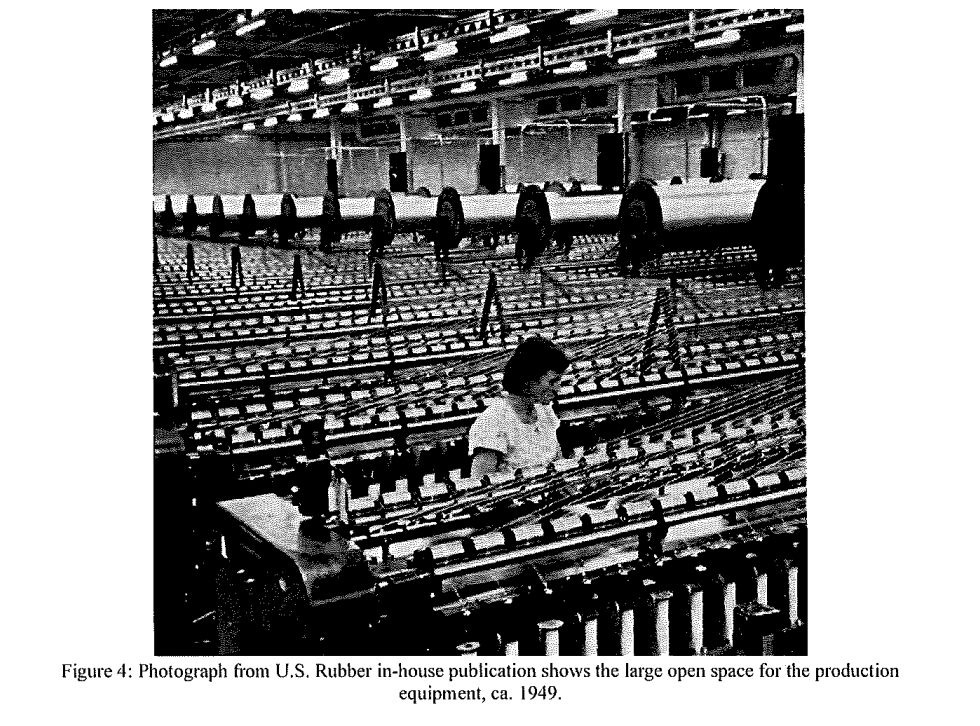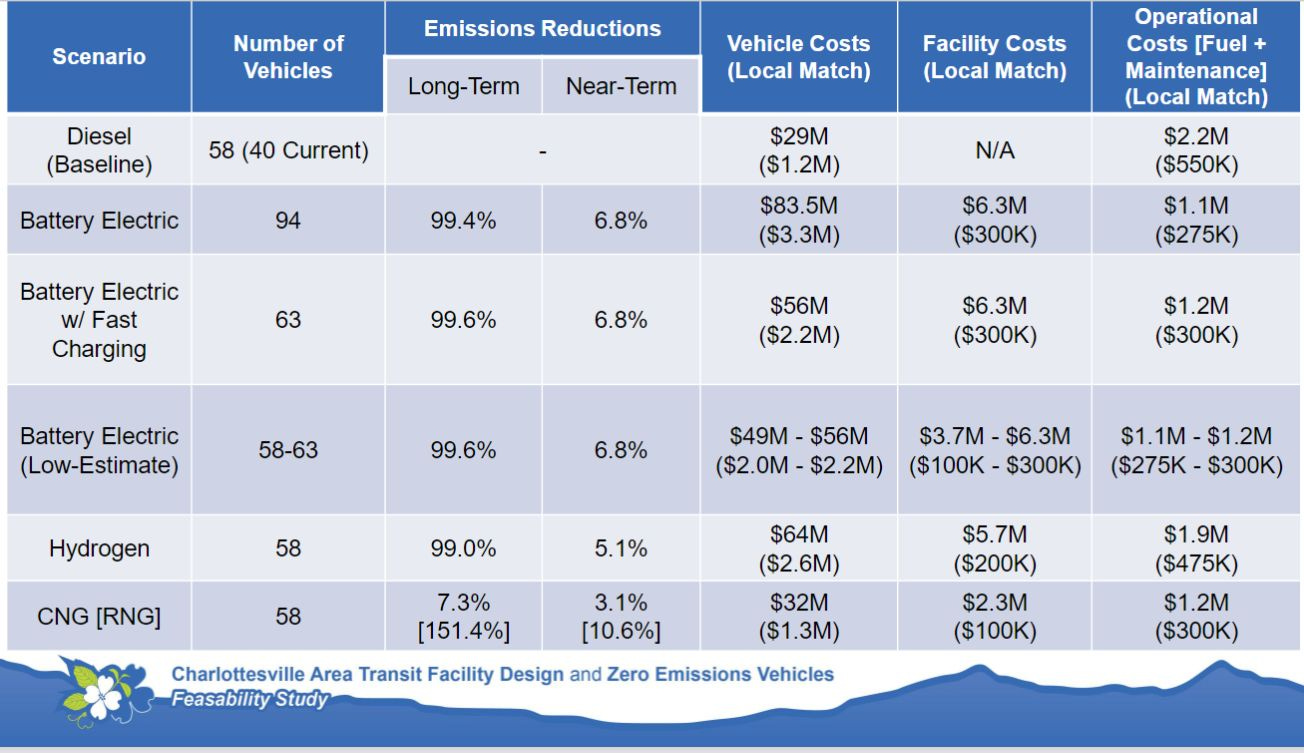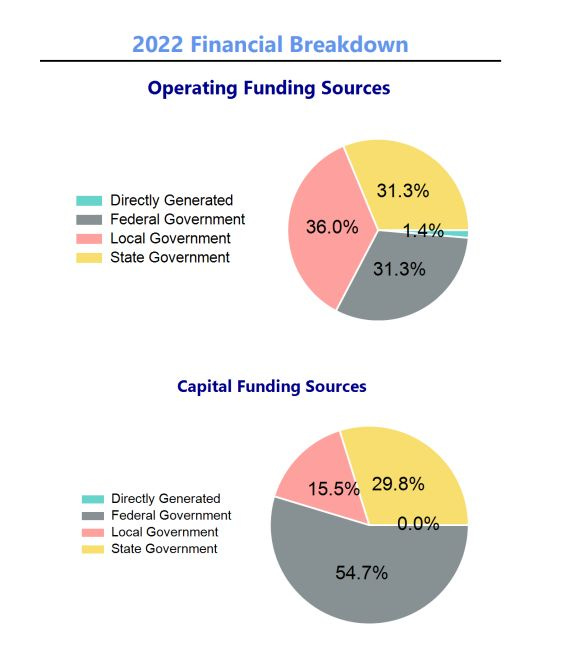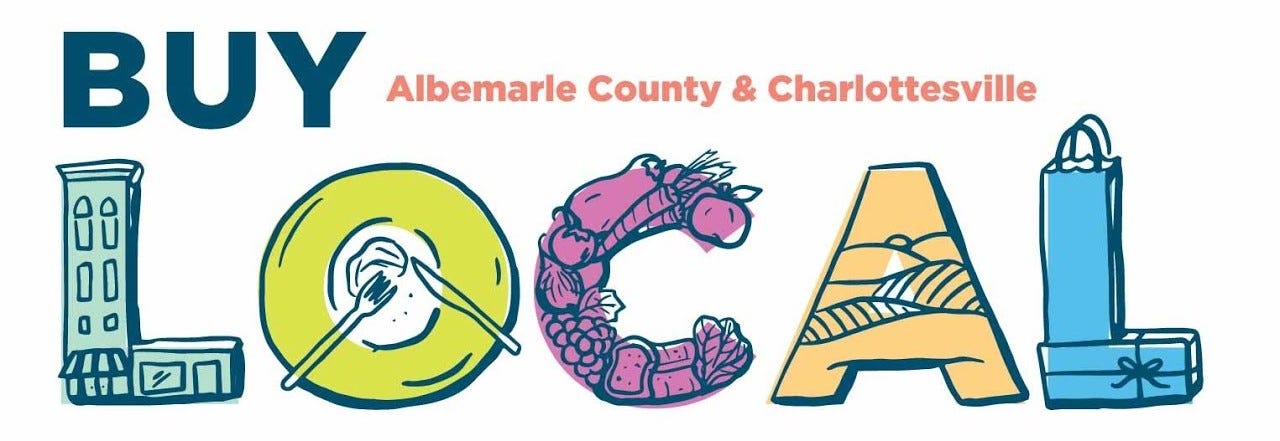What should be done about January 23? The one for this year marks 6.8 percent of the way through the orbital cycle. Items in this and every edition of Charlottesville Community Engagement happened at different points and the goal is to capture as much as possible. I’m Sean Tubbs, continuing to try to not look at fake holiday calendars for easy opening copy.
On today’s show:
Charlottesville City Manager Sam Sanders announces a new deputy and a working group on a potential city landbank
A piece of Albemarle’s industrial history is added to the Virginia Landmarks Register
The Albemarle Charlottesville Jail Authority will hold the first of three meetings on the proposed renovations
Charlottesville Area Transit’s director explains why he wants the city to test both battery-electric vehicles and hydrogen fuel cells
First shout-out: ReLeaf Cville
In today’s first subscriber supported public service announcement: ReLeaf Cville exists to reverse a worrying trend. Since 2004, Charlottesville’s Tree Canopy has declined from 50 percent to 38 percent. Two-thirds of the city’s neighborhoods are below 40 percent. ReLeaf Cville aims to change that through a series of tree plantings, preservation efforts, and education campaigns.
ReLeaf is a public / private partnership between the city tree Commission, the Nature Conservancy, City of Promise, Charlottesville Area Tree Stewards, and the Van Yahres Tree Company. Their efforts are funded through donations so consider making yours today!
Sanders appoints former Petersburg Deputy City Manager to Charlottesville position
Charlottesville City Manager Sam Sanders has rounded out his administration with the appointment of a former deputy city manager of Petersburg to an equivalent position in Charlottesville.
“Today I announced the selection of Lionel Lyons, a seasoned veteran in local government, who will join us as the deputy city manager for operations, my old job,” Sanders told City Council on Monday.
This follows on the heels of the appointment of Eden Ratliff as Deputy City Manager for Administration earlier this month. Ratliff will oversee budget, finance, and human resources whereas Lyons will oversee Neighborhood Development Services, public works, transit, and utilities.
“Both of these deputies will join us on the 5th here at your next meeting and I so looking forward to them getting here,” Sanders said.
The third deputy is Ashley Marshall who now has the title of Deputy City Manager for Social Equity. Marshall was hired by former City Manager Chip Boyles just before Sanders was hired in the middle of 2021.
Lyons served in Petersburg for four years until 2021 and before that he was a senior executive assistant to the city manager of Phoenix, Arizona. He’s been a finalist for positions in Beaumont, Texas and Missouri City, Texas.
Sanders also reported that he has formed a working group to come up with an ordinance to create a land bank. This consists of him, City Attorney Jacob Stroman, Housing Program Manager Antoine Williams, and Planning Commissioners Philip d’Oronzio and Lyle Solla-Yates.
“We met recently to have some beginning conversations,” Sanders said. “This was initiated by Mr. d’Oronzio who has been a key proponent of this particular action. In that conversation we were able to get through a lot and left the conversation with the ability to see that there is some work that we can do and we believe that we can bring back to Council for your consideration sometime later in the summer.”
Sanders will hold a budget forum tonight at 6 p.m. in Carver Recreation Center. Learn more in a press release. This would have been in the Week Ahead but was not on a list of meetings this week.
Scottsville Tire Cord Plant added to Virginia Landmarks Register
A part of Albemarle County’s industrial past has been added to the Commonwealth’s list of “historically and culturally significant properties.”
In December, the Virginia Department of Historic Resources approved the nomination of the Scottsville Tire Cord Plant Historic District to be added to the Virginia Landmarks Register.
“The Scottsville Tire Cord Plant remains remarkably intact, and is representative of a half-century of rubber cord production industry that was one of the largest employers for Scottsville, Albemarle County, and the surrounding counties of Fluvanna, Buckingham, and Nelson,” reads the introductory paragraph for the nomination.
The factory dates back to 1944 when the United States Defense Plant Corporation built it to increase the country’s capacity for rubber production. The 24-acre campus includes eight structures that contribute to the significance of public-private partnerships that existed during the Second World War.
“The Scottsville Tire Cord Plant also served as a major employer, having employed nearly 400 men and women at its peak, and thus it spurred economic growth to the rural communities that surrounded Scottsville,” the nomination continues.
The nomination describes how the plant wound up in Scottsville, a community that had not seen significant industry since the close of the Civil War when industrial buildings were destroyed. The federal Defense Plant Corporation was formed in 1940 to subsidize industries for “non-arsenal defense industries” such as producing the lining for tires using rayon. In 1944, the DPC purchased 66 acres of land in Scottsville and both the Town of Scottsville and Albemarle County covered the cost of providing water and sewer infrastructure.
The plant adjusted to post-war consumer demand and continued operations for many decades under many different owners until 2009 when the plant closed. A company called Echelon Resources recently sought a rezoning to redevelop the plant with 205 dwelling units, but Town Council voted against it in January 2023 according to The James Exchange. Minutes of Town Council meetings only date back to June 2023.

Jail authority plans three meetings on renovation project
Planning work continues for the renovation for the Albemarle Charlottesville Regional Jail, a project that will address accessibility issues but will not expand the number of beds.
On Thursday, the Jail Authority will host the first of three community meetings for members of the public to review three design options as produced by the firm Moseley Architects. The event will be from 5:30 p.m. to 7:30 p.m. at the Carver Recreation Center in the classroom lounge.
“The nice thing is that all of these meetings will be recorded,” said Supervisor Diantha McKeel, a member of the Authority Board. She announced the meeting last week at the Board of Supervisors.
There’s a Zoom link for those who want to attend virtually. The other two meetings will be on February 12 and February 27 also at the Carver Recreation Center.
The General Assembly has agreed to fund a quarter of the costs of the renovation. Elected officials in Albemarle County, Charlottesville, and Nelson County have all agreed in principle to contribute their share of the costs for planning.
Learn more about the renovation project on the ACRJ website.

Sponsored message: Buy Local
From Crozet to Barracks Road, the Downtown Mall to the Shops at Stonefield, and everywhere in between, Albemarle County and Charlottesville’s Offices of Economic Development encourage you to Buy Local as the New Year unfolds.
Buying locally supports our neighbors and community members and makes a big impact for our local economy. Local businesses are more likely to reinvest in our community and their goods and services contribute to the unique character of our community.
Learn more about how you can support local business at ShowLocalLove.org and on social media at “BuyLocalCvilleAlbemarle”
Council briefed on request to pilot two alternative fuel sources for CAT
No decision expected until February
We measure the effectiveness of local government by determining how much progress is being made toward goals, goals adopted by elected officials. Charlottesville City Council adopted a moral directive to eliminate its use of greenhouse gas emissions by 2050 and to reduce existing emissions by 2030.
Late last year, City Manager Sam Sanders elevated the Office of Sustainability from Public Works to be its own independent entity underneath his close watch. But perhaps one of the most high-profile discussion points about climate change and adaptation in this community relates to the fuel type for mass transit vehicles.
On Monday, January 22, 2024, Council finally heard the final report in a feasibility study commissioned by Charlottesville Area Transit to review the many options to inform Council’s eventual decision on how to proceed to meet the city’s overall climate goals.
“It’s been about almost 18 months now since we started down this path of putting together the alternative fuel study,” said Garland Williams, director of Charlottesville Area Transit.
Council last got an update on the study in July. To set the stage, Williams told Council on Monday that the study assumes the need to run 15 routes with 26 vehicles active during peak periods to provide enough capacity.
“The schedules that we’re talking about are for operating about 14 hours of 15 hours per day, so the recommendation that we’re going to introduce to you basically looks at getting us a model that allows us to be reliable, dependable and frequent because those are the things that make transit usable for all in this area,” Williams said.
Sam Sink is with Kimley Horn and said the study is intended to determine a preferred fuel type and to recommend a strategy and timeline for implementation. That involves considering resources available for the transition, what it would be like to operate a fleet under the new fuel source, and what sustainability benefits would result. (review the presentation)
The study reviewed three alternatives.
“First was natural gas, [which] can be either CNG (compressed natural gas) or RNG (renewable natural gas),” Sink said. “We also looked at battery-electric buses and fuel cell electric bus, also known as hydrogen.”
Sink went through the pros and cons of each type and said both types of electric vehicles would require new charging infrastructure. Natural gas vehicles would produce fewer emissions than diesel buses, but not zero.
“CNG or RNG, it is a cost-effective technology,” Sink said. “It’s also a very mature technology as there’s many agencies around the state that are using this and around the region. It’s very resilient to operate. If your power goes down, you can still fuel your buses with CNG or RNG.”
Sink said battery-electric vehicles are also a mature technology and there are zero tailpipe emissions, though it should be noted that the electricity used to charge vehicles comes from somewhere.
“There’s a definitive source of the fuel,” Sink said. “You know what your grid make-up is, and where that electricity is coming from and whether its renewable or not. You know the ultimate emissions story behind that fuel that’s being used to charge your batteries. On the con side, it may require a larger fleet. These buses do have a higher cost than diesel or CNG buses and there are range concerns and that’s kind of what drives that requirement for a larger fleet.”
Hydrogen fuel cells would also be zero-tailpipe emissions and could be operated if the power is out. However, they’re more expensive to implement.
“Also, there’s somewhat of a lack of supply of hydrogen fuel on the market right now,” Sink said. “This is more of an emerging technology so the fuel market hasn’t quite caught up.”

Williams said CAT can buy a diesel vehicle for $548,000 and the city’s cost-share responsibility for that is four percent. The city-run agency will be seeking to try out one of the alternatives in the near future but they are more expensive.
“We will be able to put within the next 60 days an order for two battery-electric vehicles,” Williams said. “When we made our submission to the state they pointed out that they thought our estimate was low so they bumped our number up. It’s basically $1.2 million per vehicle.”
This the first chance for Councilor Natalie Oschrin to ask questions about the make-up of the transit fleet. A new elected official brings fresh eyes to existing systems. Oschrin first asked if the model being used assumed replacement of large buses or if smaller vehicles could be used.
“We’re an urban style system and part of what we are trying to do is capacity,” Williams said. “To go to smaller vehicles, we don’t have the capacity to carry as many people so we would potentially have to double the size of the fleet and have them on a much higher frequency to carry as many people but right now we are 35 footers that allow us to carry 55 people seated and about another 15 to 20 standing.”
“And how, and this might be veering a little from this presentation but is ridership capacity full?” Oschrin asked.
“It depends on which route you are asking,” Williams said. “There are three routes in our system that are at capacity and having smaller vehicles would be a concern for us. Now, I caveat that because the frequency on the other routes is not where we want it to be so the ridership is not where we are hoping that it will be. If we can get it becoming more reliable and frequent, we know our ridership. There’s pent-up demand.”
Williams said there are three vehicles serving Route 5 and Route 7 during peak period.
The most recently available ridership report on the U.S. Department of Transportation’s website is from 2022 for CAT with a reported 1,156,514 unlinked trips. In 2013, CAT reported ridership of 2,405,151, a marked decline over nine years. The pandemic can’t be fully blamed for the decrease as the 2019 report showed 1,871,952 unlinked trips.
Another consideration for buses is the need to provide heat for passengers on buses during winter months. Another is the possibility of fast-charging technology for battery electric vehicles.

Sink said one of the study’s recommendations is to commit to CAT becoming emissions free by 2040, ten years ahead of the city’s larger goal. Here’s another.
“CAT should pilot two fuel types for transition, both battery-electric and hydrogen fuel cell,” Sink said.
Sink reminded Council that Williams had said procurement is already underway for two battery-electric vehicles.
“The other piece of this carbon neutrality is getting more people on the bus and those investments represent an almost doubling of CAT’s service that they have on the street today,” Sink said.
It is important to mention at this point that expansion has nothing to do with the theoretical Regional Transit Vision Plan that’s been put together by the Thomas Jefferson Planning District Commission. The CAT expansion was last reviewed by Council in May 2021 but has not been implemented. (read my story) (link to 11-30-22 vision plan)
Right now there are 40 buses and Williams said 58 are needed to allow for the expansion scheme to take place. Kimley Horn is working on a space study for that increase as well as for different fuel types. He said CAT will need to acquire land next to the existing fleet depot on Avon Street Extended in order to build a facility that could handle both recharging for both battery electric and hydrogen vehicles.
The pilot vehicles would be rotated throughout all of the routes, including the ones with challenging topography, to test their reliability.
“One of the things we’re going to do is buy an extended warranty,” William said.
“You got that phone call, too?” quipped City Councilor Lloyd Snook.
Williams said his preference is to proceed with multiple fuel types as technology changes.
“Part of the reason why we are looking at potentially doing two pilots is to make sure we get the mix of alternative fuel vehicles correct,” Williams said. “I have concerns about putting all of our eggs in one basket.
City Councilor Brian Pinkston said he could understand that, but was concerned about proceeding with a hydrogen pilot given that the technology isn’t so far along.
“We have an administration now that is pushing but we might not have an administration that’s going to be as forward thinking,” Pinkston said. “I don’t know, I can’t predict the future.”
Pinkston suggested concentrating on battery electric vehicles and pursuing the fast-charging technologies that might increase their capacity. Williams said he was concerned about securing locations for those sites along routes.
City Councilor Michael Payne was also skeptical of hydrogen given the unknowns about sourcing the fuel and whether its production itself is emissions-free.
Mayor Juandiego Wade said he is not a bus rider, but many of the people he works with as a career advisor depend on transit to get to work.
“They want the frequency,” Wade said. “They’re not saying they necessarily want them cleaner. I’m not saying that they don’t but a lot of people want it cleaner, they don’t necessarily use the transit. And I’m making a general statement.”
Williams said the system does not currently have the reliability it needs to sustain ridership, let alone provide more trips.
“We have a system where we have 40 vehicles on our property,” Williams said. “Today I only had access to 20 of them. Ten of them were the hybrid battery-electric vehicles. They have been down. They don’t work. They stay in our shop more than they are on the road.”
Council was not specifically asked to provide input but instead to just receive the information to see if there were no major objections.
City Manager Sam Sanders said Council needed time to think about the matter and to come up with additional questions before seeking a decision in February.
“I’m sure you will hear from our advocates who have interest in making some different decisions so that you will be able to have that information as well and my desire was to have come back into another work session more like what you did during the zoning ordinance back in CitySpace,” Sanders said.
And sure enough, the public comment period was filled with people seeking to influence Council’s decision. Charles McCurdy of the Fry’s Spring neighborhood is a member of the group IMPACT which has been working to study potential improvement for bus service. He said he’d been told that a lack of drivers is why some scheduled services aren’t working.
“We think that CAT drivers deserve to be paid comparable to what Richmond’s GRTC’s system pays its drivers in greater Richmond,” McCurdy said.
City resident Robert McAdams pushed for quicker action on a shift to battery electric vehicles.
“Battery powered vehicles are a proven technology,” McAdams said. “The purpose of a pilot study for Charlottesville can only be to identify local problems that need to be addressed before beginning a broad transition to these buses.”
Other speakers called for fair wages for transit workers, who are now engaged in collective bargaining. Greg Weaver of the Charlotteville chapter of Democratic Socialists of America critiqued the third-party attorney hired by the city to handle the negotiations.
“CAT workers and their union representation have made public statements attesting to the outside attorney that the city hired has been acting adversarially and cynically during the bargaining process,” Weaver said.
Weaver said DSA demands changes that improve bus drivers’ lives, which would improve the reliability of the overall system.
Lisa Glassco urged the city to not buy any more diesel buses and to make the shift now to battery-electric vehicles even with potential risks.
“Many companies are working on making safer, cheaper, and easier batteries at this time,” Glassco said. “That doesn’t have to slow down the transition.”
Several paid and unpaid members of advocacy groups also made comments. More on this topic and transit as Charlottesville Community Engagement continues.
Reading material:
Madison Dems Meet Candidate Pool Vying For Spanberger Seat, MadRapp Reporter, January 19, 2024
Drought watch advisory lifted for much of Virginia, CBS19, January 19, 2024
Now what? New development code brings a new era for Charlottesville’s built environment, Sean Tubbs, C-Ville Weekly, January 17, 2024
As some rural Virginia counties reject solar farms, legislators want to step in, Dave Ress, Richmond Times-Dispatch by way of Charlottesville Daily Progress (paywall), January 17, 2024
Democrats propose budget language to return Virginia to carbon market, Charlie Paulinn, Virginia Mercury, January 22, 2024
The wheels of #627 end and end
It’s another edition that perhaps went a little too long on one topic, but sometimes that’s what happens. There are advantages to having a loose format, and that’s how it will be for quite some time.
There’s also more to come from the City Council meeting as well as all of the other meetings I record. I really do thank those of you paying what you can to make sure the audience can keep growing.
Paid subscribers were able to get a first look yesterday at the November 2023 property transactions in Charlottesville, and hopefully there will be another such installment for December before the end of the week.
Can’t pay? That’s okay. Please keep reading and sending the work on to others.
If you sign up for Ting at this link and enter the promo code COMMUNITY, you’ll get:
Free installation
A second month for free
A $75 gift card to the Downtown Mall

















Share this post